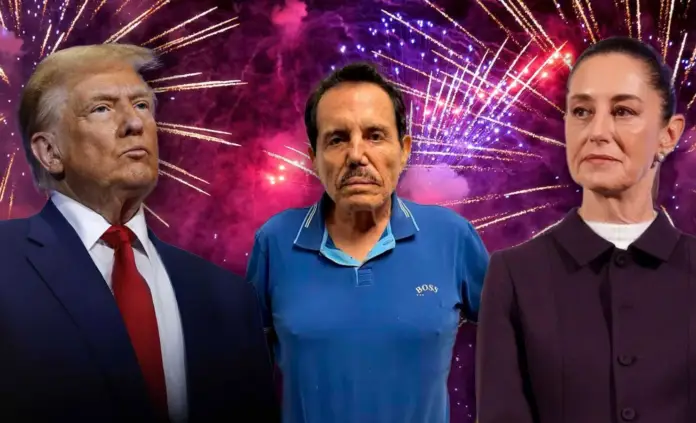
Mexico experienced one of its most transformative years in recent history in 2024 with events such as the election of its first female president, the end of Andrés Manuel López Obrador’s public life, record migration, and the Sinaloa Cartel struggle.
These are the ten events that marked the year in Mexico.
- Sheinbaum, the first female president
Claudia Sheinbaum became the first female president of Mexico after winning the June 2 elections with a record of almost 36 million votes, nearly 60 percent of the total, the highest proportion since the 70.96 percent obtained by Miguel de la Madrid in 1982, when the government was still organizing the elections.
From Elon Musk’s perspective to the action of the unknown Mexico: Innovation, risk and strategic alliances for a transformative 2025
From Elon Musk’s perspective to the action of the unknown Mexico: Innovation, risk and strategic alliances for a transformative 2025
“Above all, it is the recognition of the people of Mexico to our transformation project. I am also grateful because, for the first time in 200 years of the republic, I will become the first woman president of Mexico,” declared Sheinbaum in her first message after the results.
- The end of López Obrador’s public life
The arrival of Sheinbaum to power, on October 1, implied the end of the public life of the then president, Andrés Manuel López Obrador (2018-2024), an almost omnipresent figure in Mexican politics since 1996, when he was leader of the now extinct Party of the Democratic Revolution (PRD).
López Obrador, who was a three-time presidential candidate from 2006 to 2018, has retired to a ranch in Palenque, in southeastern Mexico, where he has promised not to make statements, although he is writing a book on pre-Hispanic civilizations.
- The hegemony of the ruling party in Congress
The ruling party alliance of the National Regeneration Movement (Morena), the Labor Party (PT) and the Green Ecologist Party of Mexico (PVEM) has controlled two-thirds of the Chamber of Deputies and the Senate since September, which allows it to reform the Constitution without obstacles.
This power has not been seen since 1982, during the time of President De la Madrid, when the Institutional Revolutionary Party (PRI) was hegemonic in the country.
- Judicial reform
Thanks to his new majorities in Congress, López Obrador enacted the constitutional reform to the Judicial Branch on September 15, meaning that starting in June 2025, Mexico will elect judges, magistrates, the Supreme Court, the Electoral Tribunal and the Judicial Disciplinary Tribunal at the polls by popular vote.
The modification provoked an unprecedented strike by judges and workers of the Judicial Branch.
- Trump’s uncertainty
Donald Trump’s second victory in the presidential elections on November 5 in the United States causes economic uncertainty in Mexico, especially due to his threat to impose 25 percent tariffs on all Mexican products if he does not stop the “invasion” of migrants and drugs, especially fentanyl.
- The end of the ‘superpeso’
The Mexican peso has accumulated a depreciation of more than 20 percent since the first day of the year, according to official data from the Bank of Mexico, amid the uncertainty caused by Trump and policies of the new Government, such as judicial reform.
This has completely erased the phenomenon of the ‘superpeso’, the record appreciation of almost 13 percent of the Mexican currency in 2023.
- Record migration
Although the daily encounter of undocumented immigrants at the United States border has decreased by 75 percent since December 2023, the Government of Mexico detected a record of more than 925,000 irregular migrants from January to August last year, a year-on-year increase of almost 132 percent.
- The capture of ‘El Mayo’ Zambada and the drug war
On July 25, the United States captured Ismael ‘El Mayo’ Zambada, co-founder of the Sinaloa Cartel, and Joaquín Guzmán López, son of Joaquín ‘El Chapo’ Guzmán, who handed him over after forcing him to board a plane that landed near the American city of El Paso, Texas, according to the official version.
This unleashed an internal struggle between the factions of Los Chapitos and Los Mayos in Sinaloa, a state in the northwest of the country that has accumulated almost 600 murders since September 9, according to the government.
- Armed conflict on the southern border
More than 400 Mexicans fled to Guatemala in July due to the dispute between the Sinaloa Cartel and the Jalisco Nueva Generación Cartel in Chiapas, a state on the southern border where they fight over human and drug trafficking routes from Central America.
Indigenous organizations denounce an atmosphere of “civil war” or “armed conflict” in Chiapas, where the cartels have killed, disappeared or displaced tens of thousands of inhabitants of their communities.
- “Historic” fight against fentanyl
Faced with pressure from the United States, the Mexican government reported on December 2 the “largest seizure ever made” of fentanyl in an operation in Sinaloa, where it confiscated nearly 300 kilograms of this synthetic drug in a home and another 800 kilograms in a van.
Sheinbaum highlighted that this is equivalent to more than 20 million doses, which could have generated around 8 billion pesos (about 400 million dollars) on the black market.
Source: elfinanciero




